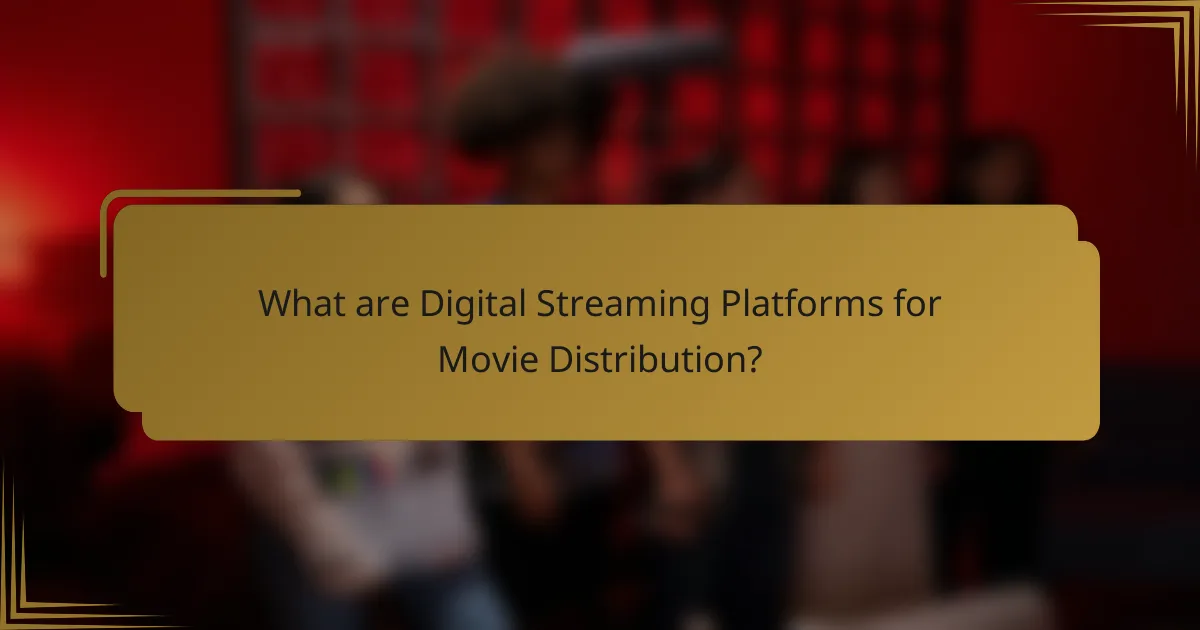
What are Digital Streaming Platforms for Movie Distribution?
Digital streaming platforms for movie distribution are online services that deliver films directly to viewers via the internet. These platforms allow users to access a wide range of movies on-demand. Examples include Netflix, Hulu, Amazon Prime Video, and Disney+. They operate on subscription models or offer pay-per-view options. Digital streaming platforms have transformed how audiences consume films. They provide convenience by allowing viewing on various devices, such as smartphones, tablets, and smart TVs. The global streaming market was valued at approximately $50 billion in 2020, highlighting its significance in the entertainment industry.
How do Digital Streaming Platforms differ from traditional movie distribution methods?
Digital streaming platforms differ from traditional movie distribution methods primarily in their delivery and accessibility. Streaming platforms provide on-demand access to content via the internet. This allows users to watch movies anytime and anywhere on various devices. Traditional distribution relies on physical media and theatrical releases. Viewers must visit cinemas or purchase DVDs to access films.
Streaming services often offer subscription models, providing unlimited access for a monthly fee. Traditional methods usually involve one-time purchases or ticket sales. Additionally, streaming platforms can release films simultaneously worldwide. Traditional distribution often follows a staggered release schedule, varying by region.
The convenience of streaming has led to increased audience engagement. According to a 2020 report by Statista, over 70% of U.S. households subscribed to at least one streaming service. This indicates a significant shift in consumer behavior towards digital platforms.
What are the key features of Digital Streaming Platforms?
Digital streaming platforms provide on-demand access to audio and video content. Key features include subscription models, allowing users to pay for access. They offer a vast library of content, including movies, series, and documentaries. High-definition streaming is often available, enhancing the viewing experience. User-friendly interfaces enable easy navigation and content discovery. Personalization features recommend content based on viewing habits. Many platforms support multiple devices, allowing users to watch on TVs, tablets, and smartphones. Offline viewing options let users download content for later access.
How do user interfaces impact the viewing experience?
User interfaces significantly impact the viewing experience by influencing user engagement and satisfaction. A well-designed interface enhances navigation, making it easier for viewers to find content. For example, intuitive layouts reduce search time and frustration. Additionally, responsive designs improve accessibility across devices. Research shows that 88% of users are less likely to return to a site after a bad experience. Visual elements, such as thumbnails and descriptions, also affect user choices. Clear information presentation helps viewers make informed decisions. Overall, an effective user interface is crucial for a positive viewing experience on digital streaming platforms.
Why are Digital Streaming Platforms becoming popular for movie distribution?
Digital streaming platforms are becoming popular for movie distribution due to their convenience and accessibility. Consumers can watch movies anytime and anywhere with an internet connection. This flexibility caters to modern viewing habits. Additionally, streaming platforms often offer a vast library of content. This extensive selection attracts a wide audience. Subscription models provide cost-effective options compared to traditional cinema. According to a report by PwC, global subscription video on demand revenue reached $50 billion in 2020. The COVID-19 pandemic accelerated this trend, as people sought entertainment at home. Overall, digital streaming platforms are reshaping how movies are distributed and consumed.
What trends are driving the growth of Digital Streaming Platforms?
Increased consumer demand for on-demand content is driving the growth of digital streaming platforms. Viewers prefer flexibility in watching content anytime and anywhere. The rise of mobile devices enhances accessibility to streaming services. Original content production by platforms attracts subscribers and retains existing users. Subscription models provide predictable revenue streams for providers. The global shift towards internet connectivity supports wider streaming adoption. Data analytics helps platforms personalize user experiences, increasing engagement. Competitive pricing and bundling options appeal to a broader audience.
How do consumer preferences influence platform success?
Consumer preferences significantly influence platform success by determining user engagement and retention. When platforms align their offerings with consumer tastes, they attract more subscribers. For example, platforms that prioritize popular genres or trending content see higher viewership. Research shows that 70% of users prefer platforms that recommend personalized content. This personalization is crucial for maintaining user interest. Additionally, consumer feedback shapes platform features and content libraries. Platforms that adapt to viewer preferences can improve their competitive edge. Therefore, understanding and responding to consumer preferences is vital for the success of digital streaming platforms.

What are the major types of Digital Streaming Platforms?
The major types of digital streaming platforms include subscription-based services, ad-supported platforms, and transactional video on demand (TVOD) services. Subscription-based services, like Netflix and Hulu, allow users to access content for a monthly fee. Ad-supported platforms, such as YouTube and Pluto TV, provide free content funded by advertisements. Transactional video on demand services, like Amazon Prime Video and Google Play Movies, enable users to rent or purchase individual titles. Each type serves different consumer preferences and business models in the digital streaming landscape.
What distinguishes subscription-based platforms from ad-supported platforms?
Subscription-based platforms require users to pay a regular fee for access to content. This model offers an ad-free experience, allowing uninterrupted viewing. In contrast, ad-supported platforms provide free access to content, funded by advertisements. Users on these platforms must watch ads before or during content. Subscription platforms often have exclusive content not available elsewhere. Ad-supported platforms may have limited content due to licensing restrictions. Data shows that 70% of viewers prefer ad-free experiences, highlighting the appeal of subscriptions.
How do pricing models vary across different platforms?
Pricing models vary significantly across different digital streaming platforms. Subscription-based models charge users a recurring fee for access to content. For example, Netflix offers monthly subscriptions with varying tiers based on the number of screens and video quality. Transactional models, like Amazon Prime Video, allow users to rent or purchase individual titles. This model provides flexibility for users who prefer not to commit to a subscription. Ad-supported models, such as those used by Hulu, offer free access to content with interruptions for advertisements. This approach monetizes viewership without upfront costs for users. Freemium models, like those used by Spotify, provide basic content for free while charging for premium features. Each model reflects different strategies to attract and retain users while maximizing revenue.
What are the advantages and disadvantages of each type?
The advantages of digital streaming platforms include accessibility and convenience. Users can watch content anytime and anywhere with an internet connection. Streaming services often provide a vast library of movies and shows. This variety caters to diverse viewer preferences. Additionally, subscription models typically offer cost savings compared to traditional cable.
Disadvantages include potential internet dependency and quality issues. Streaming requires a stable internet connection for optimal viewing. Users may experience buffering or reduced quality during peak usage times. Moreover, some platforms rotate content frequently, leading to the loss of favorite titles. Licensing restrictions may also limit access to certain films.
What role do original content and licensing play in Digital Streaming Platforms?
Original content and licensing are crucial for digital streaming platforms. Original content attracts subscribers and differentiates platforms from competitors. Licensing allows platforms to offer a wider variety of existing films and shows. This combination enhances user engagement and retention. For instance, Netflix’s investment in original series like “Stranger Things” has significantly increased its subscriber base. Additionally, licensed content from popular franchises provides immediate value to users. According to a 2021 report by PwC, original programming can increase viewer loyalty by up to 50%. Thus, both original content and licensing are essential for the success of digital streaming platforms.
How do platforms decide what content to produce or license?
Platforms decide what content to produce or license based on audience demand and market trends. They analyze viewer data to identify popular genres and themes. Platforms also assess competition to ensure unique offerings. Licensing agreements are often influenced by the potential for return on investment. They consider production costs against projected subscriber growth. Additionally, platforms may prioritize original content to differentiate themselves. Audience feedback and engagement metrics further guide content decisions. This data-driven approach helps platforms maximize viewer satisfaction and profitability.
What impact does original content have on subscriber retention?
Original content significantly enhances subscriber retention. Streaming platforms that offer unique, high-quality original content see increased loyalty from their subscribers. A study by Deloitte found that 61% of consumers cite original programming as a key factor in their subscription decisions. Additionally, platforms like Netflix report that original series often lead to higher engagement rates. This engagement translates to lower churn rates. Subscribers are less likely to cancel when they feel they have exclusive content to enjoy. Therefore, original content is a critical driver of subscriber retention on digital streaming platforms.

How do Digital Streaming Platforms manage content delivery and technology?
Digital streaming platforms manage content delivery and technology through a combination of content distribution networks (CDNs), adaptive bitrate streaming, and cloud computing. CDNs are used to distribute content efficiently across various geographic locations. This reduces latency and improves load times for users. Adaptive bitrate streaming adjusts video quality in real-time based on the user’s internet speed. This ensures a smooth viewing experience without buffering. Cloud computing provides scalable storage and processing power for handling large volumes of content. Platforms like Netflix utilize these technologies to deliver high-quality streaming to millions of users simultaneously. According to a 2021 report by Statista, Netflix had over 200 million subscribers, showcasing the effectiveness of their technology in managing content delivery.
What technologies are essential for streaming content effectively?
Essential technologies for effective content streaming include high-speed internet, adaptive bitrate streaming, content delivery networks (CDNs), and video codecs. High-speed internet ensures smooth data transmission. Adaptive bitrate streaming adjusts video quality based on user bandwidth. CDNs distribute content across multiple servers to reduce latency. Video codecs like H.264 and H.265 compress video files for efficient delivery. These technologies collectively enhance user experience and minimize buffering. Statistics show that 82% of viewers abandon streams that buffer repeatedly, highlighting the importance of these technologies in maintaining viewer engagement.
How do bandwidth and compression affect streaming quality?
Bandwidth and compression significantly impact streaming quality. Bandwidth refers to the amount of data that can be transmitted over an internet connection in a given time. Higher bandwidth allows for more data to be sent simultaneously, leading to better video quality. Compression reduces the file size of the video, making it easier to stream over lower bandwidths. However, excessive compression can degrade video quality, causing pixelation or blurriness. For instance, streaming services often recommend a minimum bandwidth of 25 Mbps for 4K content. This ensures optimal quality without interruptions. In summary, adequate bandwidth combined with efficient compression techniques is crucial for high-quality streaming experiences.
What role does cloud computing play in content delivery?
Cloud computing plays a crucial role in content delivery by providing scalable resources for streaming services. It enables the storage and distribution of large amounts of data efficiently. Cloud platforms allow for on-demand access to content from anywhere with an internet connection. This flexibility enhances user experience by reducing latency during streaming. Additionally, cloud computing supports content delivery networks (CDNs) that optimize the delivery speed. According to a report by Cisco, global IP traffic will reach 4.8 zettabytes per year by 2022, highlighting the need for robust cloud solutions. Overall, cloud computing is essential for managing the vast data requirements of digital streaming platforms.
How do Digital Streaming Platforms ensure user engagement and retention?
Digital streaming platforms ensure user engagement and retention through personalized content recommendations. They utilize algorithms that analyze user behavior and preferences. This tailored experience keeps viewers interested in the content offered.
Additionally, platforms frequently update their libraries with new releases. This strategy encourages users to return for fresh content regularly. Features like binge-watching options and autoplay enhance user experience.
Moreover, social sharing features allow users to discuss content with peers. This interaction fosters a community around the platform. Exclusive content and original programming also attract and retain subscribers.
According to a report by Deloitte, 61% of consumers prefer platforms that offer personalized recommendations. This statistic highlights the effectiveness of tailored content in driving engagement.
What strategies do platforms use for personalized recommendations?
Platforms use algorithms to analyze user behavior for personalized recommendations. They track viewing history, ratings, and search queries. Collaborative filtering identifies patterns among similar users. Content-based filtering suggests titles based on individual preferences. Machine learning models refine recommendations over time. Data from user interactions enhances accuracy. A/B testing assesses the effectiveness of different recommendation strategies. These methods increase user engagement and satisfaction, leading to higher retention rates.
How important are social features in enhancing user interaction?
Social features are crucial in enhancing user interaction on digital streaming platforms. They facilitate community engagement and foster connections among users. Features like commenting, sharing, and rating allow users to express opinions and share recommendations. This interaction leads to increased user retention and satisfaction. Research shows that platforms with robust social features experience higher user engagement rates. For instance, a study by the Pew Research Center found that 70% of users engage more with content when social features are present. Thus, social features significantly contribute to a more interactive and enjoyable user experience.
What are best practices for optimizing the use of Digital Streaming Platforms?
Utilizing digital streaming platforms effectively requires strategic practices. Prioritize high-quality content to attract and retain viewers. Implement user-friendly interfaces to enhance viewer experience. Optimize video resolution and streaming speed to reduce buffering. Leverage data analytics to understand viewer preferences and tailor content accordingly. Promote content through social media and email marketing to increase visibility. Regularly update the platform with fresh content to encourage repeat visits. Establish partnerships with other platforms for broader distribution. These practices enhance engagement and increase subscriber retention rates.
How can users choose the right platform for their needs?
Users can choose the right platform for their needs by evaluating several key factors. First, they should consider the type of content they want to access. Different platforms specialize in various genres and formats. Next, users should assess the pricing models. Subscription fees, pay-per-view, and ad-supported options vary widely. Additionally, users should examine the platform’s user interface and ease of navigation. A seamless experience enhances content discovery. Connectivity options are also crucial. Users need to ensure compatibility with their devices, such as smart TVs, tablets, or smartphones. Furthermore, users should look into the platform’s content library size and quality. A larger selection often provides more viewing choices. Lastly, reading user reviews can offer insights into the platform’s reliability and customer service. These factors collectively guide users in selecting the most suitable streaming platform for their preferences.
What tips can enhance the streaming experience for viewers?
To enhance the streaming experience for viewers, ensure a stable internet connection. A minimum speed of 25 Mbps is recommended for high-definition streaming. Use wired connections when possible to reduce latency. Optimize device settings for streaming quality. This may include adjusting resolution and enabling hardware acceleration. Regularly update streaming apps to access the latest features and improvements. Consider using ad-free subscriptions for uninterrupted viewing. Lastly, utilize features like offline downloads for convenience. These tips can significantly improve the overall viewing experience by minimizing buffering and maximizing quality.
Digital streaming platforms for movie distribution are online services that deliver films directly to viewers via the internet, offering on-demand access to a vast library of content. This article explores the differences between digital streaming and traditional distribution methods, key features of streaming platforms, and the factors driving their popularity, including consumer preferences and technological advancements. It also examines the impact of original content, licensing, and user engagement strategies on platform success. Additionally, the article discusses various types of streaming platforms, pricing models, and best practices for optimizing the streaming experience for users.




